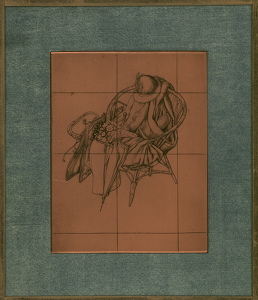

 Hover over the painting to magnify (there may be an initial delay while the magnified image is loaded)
Hover over the painting to magnify (there may be an initial delay while the magnified image is loaded)Robert Austin (1895-1973):
Souvenir of Paris, 1920's
Passe-partout (ref: 1605)
Line engraving, original copper plate 5.7 x 4.5 in. (14.6 x 11.5 cm)
See all works by Robert Austin engraving plate print interiors leisure still lifes 1.PORTRAIT OF AN ARTIST
Provenance: The Artists Family

Literature: Campbell Dodgson, Robert Austin, Twenty-One Gallery, 1930; Gordon Cooke, Drawings and Prints by Robert Austin, London, The Fine Art Society, 2001.
Llewellyn, Sacha, and Paul Liss. Portrait of an Artist. Liss Llewellyn, 2021, p.29.
This image is not recorded in Campbell Dodgson and was possibly never editioned.
It is possible that Souvenirs of Paris relates to Austin's journeys to and from the British School at Rome, when he passed via Paris by train. He was Rome Scholar in Engraving from 1922-1925. In 1924 he married Ada (May) Harrison with whom he collaborated on Some Tuscan Cities (London 1924) and Some Umbrian Cities (London 1925). It is tempting to imagine that this souvenir - the artist represented by the two portfolios which lean towards the bouquet of flowers, feathered hat and fur trimmed coat - recalls their courtship.
Although the date of this engraving is not recorded, Michael Campbell has suggested that the style and design accord with Austin’s engravings of the period 1940-1953.
Robert Austin's original etching plates were rediscovered in 2007. They
represents all aspects of the artists
oeuvre, from his first engraving (The Bridge, 1913 ) to his his last
(Frost in May 1971). Although, as was common practise amongst print
makers, Austin cancelled his plates after their edition run, the manner
in which he did this is remarkable. Far from defacing the compositions
by scratching lines across the centre, or drilling holes in the plates,
Austin drew precise lines of different proportions, dissecting each
composition, responding individually to each image. As such the
geometry of each composition appears heightened, and the plates take on
a abstract beauty of their own.
It is generally acknowledged that Austin was one of the greatest
exponents of line engraving of the Twentieth century. Campbell Dodgson,
keeper of Prints and Drawings at the British Museum, who compiled the
standard reference work on Austins' work, compared his work to that of
Durer noting that Austin had 'more than a touch of that master in him'
(Robert Austin, Twenty-One, 1930 Gallery).
Austin's period of greatest acclaim was during the etching boom of the
1920s (which ended abruptly with the Wall Street Crash).
Later works however, (for instance Girl by a gate,1930 and Empty
Church, Concarneau, 1949,) demonstrate that Austin was still at the
height of his powers long after his period of greatest acclaim.
 Modern British Prints
Modern British Prints




